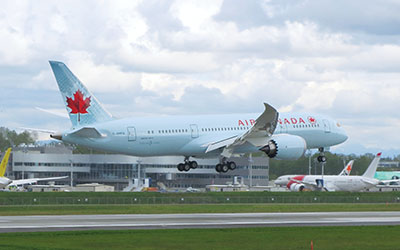
Features
Airlines
Alternate Approach: Living the dream
It was a sight to behold. Hundreds of Air Canada (AC) elite passengers, some with more than one million miles under their belt
July 7, 2014 By David Carr
It was a sight to behold. Hundreds of Air Canada (AC) elite passengers, some with more than one million miles under their belt, waiting for more than an hour inside a hanger at Pearson International Airport to catch a glimpse of the airline’s future: the first Boeing 787 Dreamliner.
 |
|
| The pure magic of the 787 is not in its hubbing potential but on point-to-point. PHOTO: Air Canada
|
Since April 1, 1960, when Trans-Canada Air Lines’ first Douglas DC-8 screamed out of Montreal’s Dorval Airport, AC has integrated 13 different types of jetliners into its fleet, including airplanes operated by Canadian Airlines at the time of the merger.
More than any jetliner that arrived ahead of it, the 787 is perhaps AC’s signature aircraft – an airplane that appears almost tailor-made for the long and thin routes that would make up the bulk of Canada’s global marketplace. Like the country it serves, AC has historically punched above its weight internationally – a lot of that during its time as a Crown Corporation when money was a trade-off for flying the flag.
Competing in a crowded domestic market that is certain to grow tighter as WestJet Encore expands, AC’s more expansive global ambitions have been pinched by the 767, an airplane the airline has clearly outgrown. The older Boeing may have had the right number of seats for some of the longer and thinner routes the airline wants to serve (the Toronto to Rio de Janerio route that will be launched in December for example), but its limited range blocked AC from going the distance to press its award-winning cabin service advantage into new markets, especially in the surging Asian markets.
Now is where the dream begins: a fleet of 787s, high-density triple-sevens and a $360-million refurbishment of older 777s with the new, so-called International Cabins beginning in 2015 (and a smaller number of Airbus A330s) to turn primary hubs in Toronto and Vancouver into global crossroads, boosting revenue by connecting the dots between Asia, Europe and the United States. The model, for Toronto at least, is Amsterdam, where KLM, serving a population half the size of Canada, built Schipol into a major connector airport serving 52.5 million passengers last year. Another example is Emirates, where the Dubai (population 2.1 million) airport is expected to surpass London Heathrow as the world’s busiest international airport. But that’s a story for another day.
Still, the pure magic of the 787 is not in its hubbing potential but on point-to-point. Early on, Airbus and Boeing bet on very different visions of the future of air transport when launching the A380 and 787. Boeing clearly won the bet, although Airbus hedged wisely by launching the A350. It is now AC’s turn to cash in. A new daily service from Toronto to Tokyo Haneda will be joined with services to Tel Aviv, Vancouver to Shanghai, a return to India and potential to fly deep into China beyond the big too destinations.
To date, much has been written about swapping out 767s with an airplane that offers superior range and economics. What does that mean to markets outside the two primary hubs? Over the long term, AC has greater flexibility to open the under-served Maritime and Atlantic provinces to a broader menu of international destinations (AC recently announced year-round services between St. John’s and Heathrow), expand Montreal as a secondary hub with point-to-point service to Asia and elsewhere, and directly connect Calgary with China, a route coveted by the Calgary Airports Authority.
The question now is: who will be next? WestJet is facing the same saturated domestic market as AC, even as Encore carves out greater share regionally. As the economics of longer-distance leisure travel, especially to Asia, become more attractive as a result of Canada’s population demographic and aircraft such as the 787 and A350, expect a larger share of the market to book vacation packages to destinations that are out of reach of Air Transat, an Airbus airline, with its current fleet.
What the 787 will not do from a passenger’s perspective is satisfy an expectation for significantly lower air fares. A lot of balls get juggled when setting fares, and the 787s fuel efficiency and economics are easily offset by currency exchanges, soaring fuel prices and taxation, such as an Ontario proposal to raise aviation fuel taxes two cents a litre. In a capital-intense industry with paper-thin profit margins, a slowing of fare increases is likely the best the market can hope for. After all, the airplane was christened Dreamliner, not Miracleworker.
David Carr is a Wings writer and columnist.